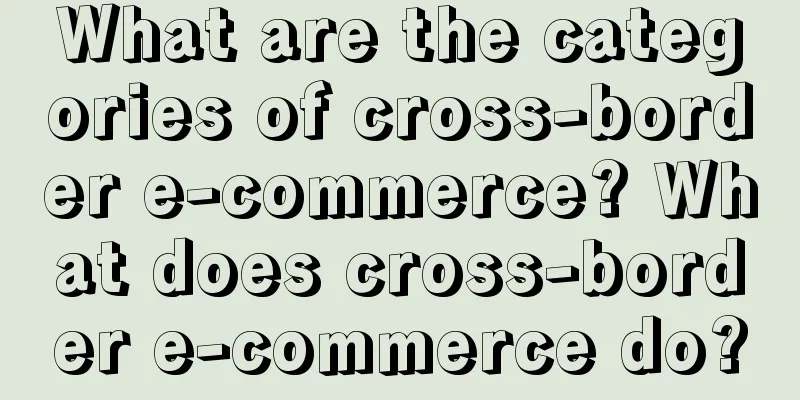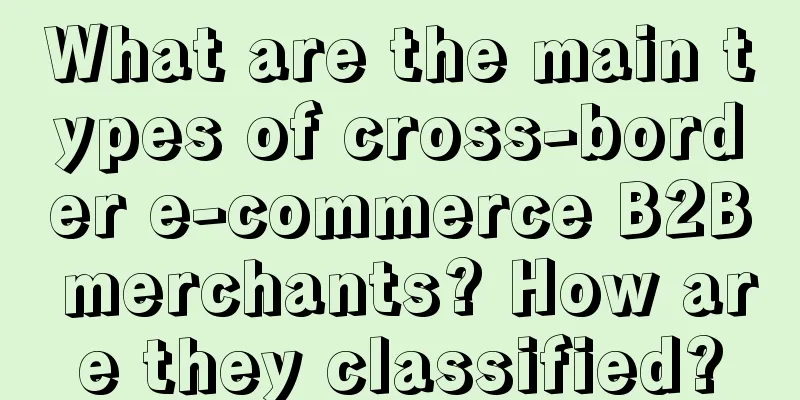What are the categories of cross-border e-commerce? What does cross-border e-commerce do?

|
With the advancement of globalization, cross-border e-commerce has gradually emerged as a new type of international trade model. Different from traditional international trade, cross-border e-commerce covers multiple dimensions of business. This article will explore the classification of cross-border e-commerce in depth to help readers have a more comprehensive understanding of this booming industry. 1. What does cross-border e-commerce do? Cross-border e-commerce refers to a business model that enables sellers and buyers to trade goods across national borders through the Internet platform. Its main businesses include: International trade: Conduct international trade of goods through cross-border e-commerce platforms to achieve international sales of goods. Logistics services: Provide global logistics services, including international transportation, customs clearance, delivery and other links to ensure the smooth circulation of goods. Payment service: Provide convenient payment services for cross-border transactions and support currency settlement in different countries and regions. Market expansion: Assist sellers to expand their markets globally and attract more international buyers. Overseas warehousing: Establish warehousing systems in various countries to achieve fast delivery of goods and localized services. After-sales service: Provide global after-sales service, including return, exchange, repair, etc. 2. Classification of cross-border e-commerce According to different business models and business scopes, cross-border e-commerce can be divided into several categories: B2C (Business to Consumer): The B2C model refers to merchants selling goods directly to consumers. In cross-border e-commerce, some well-known B2C platforms such as Amazon and AliExpress belong to this category. C2C (Consumer to Consumer): The C2C model refers to transactions between individuals, and the platform provides transaction matching and payment services. eBay is a representative C2C platform in cross-border e-commerce. B2B (Business to Business): The B2B model refers to transactions between businesses, mainly serving wholesale and procurement. Alibaba's international site is a typical B2B platform. O2O (Online to Offline): The O2O model achieves offline transactions by attracting traffic online. In cross-border e-commerce, some online platforms promote product sales by cooperating with offline physical stores. D2C (Direct to Consumer): The D2C model refers to a brand selling directly to consumers and building a brand image through its own channels. This model is gradually gaining attention in cross-border e-commerce. F2C (Factory to Consumer): The F2C model refers to factories selling products directly to consumers, bypassing middlemen. This model is usually implemented through private brands and independent sites. C2B (Consumer to Business): The C2B model refers to consumers making demands and companies providing customized products or services based on the demands. This model is more prominent in some areas of customized goods. M2C (Manufacturer to Consumer): The M2C model refers to manufacturers selling directly to consumers. This model is implemented through private brands and independent sites, which is different from the traditional channel form. The above classifications are not absolutely independent. Many cross-border e-commerce platforms may cover multiple models and form a diversified business structure. |
<<: Why did Amazon's natural traffic suddenly drop? How can I increase Amazon's natural traffic?
Recommend
Have Yili and Mengniu lost their voice in the Spring Festival marketing war?
Many brands have begun to market their products du...
How does marketing guru Lei Jun grasp consumer psychology?
Xiaomi Motors' first model, SU7, was officiall...
The life and death of new consumption: price war, franchise competition, and profit protection | Please answer 2023
In 2023, young people are no longer brainwashed by...
The new seven deadly sins of brand advertising
In this article, the author shares the vicious cir...
A new MVP emerges in the 40 billion short drama market
As AI technology continues to deepen in the field ...
The core of the brand: products
Consumers who have grown up surrounded by Xiaohong...
Xiaohongshu’s standardized process for post-investment review
Exploring the review methods of Xiaohongshu’s adve...
To achieve recognition, to break out of the circle, and to productize, this is my half-year entrepreneurial review and experience summary
This article is based on personal work experience ...
This Double 11, we went to Li Jiaqi's live studio
Since the eyebrow pencil incident, Li Jiaqi has be...
How to correctly view local life live broadcast?
This article first talks about the fact that the m...
Stop calling customers and sending group messages on WeChat
Why is it that marketing services that cast a wide...
Can I apply for early payment from Amazon? How long does it usually take to get the payment back?
Just like the rules of Taobao platform, the money ...
Can I join Lazada now? Is it easy to pass the review?
Ladaza is one of the promising e-commerce platform...
The public account [Content Boost] is in internal testing, and the traffic is coming!
WeChat official accounts recently launched a new f...
Loneliness has become a business!
How did the loneliness economy model come about? U...









